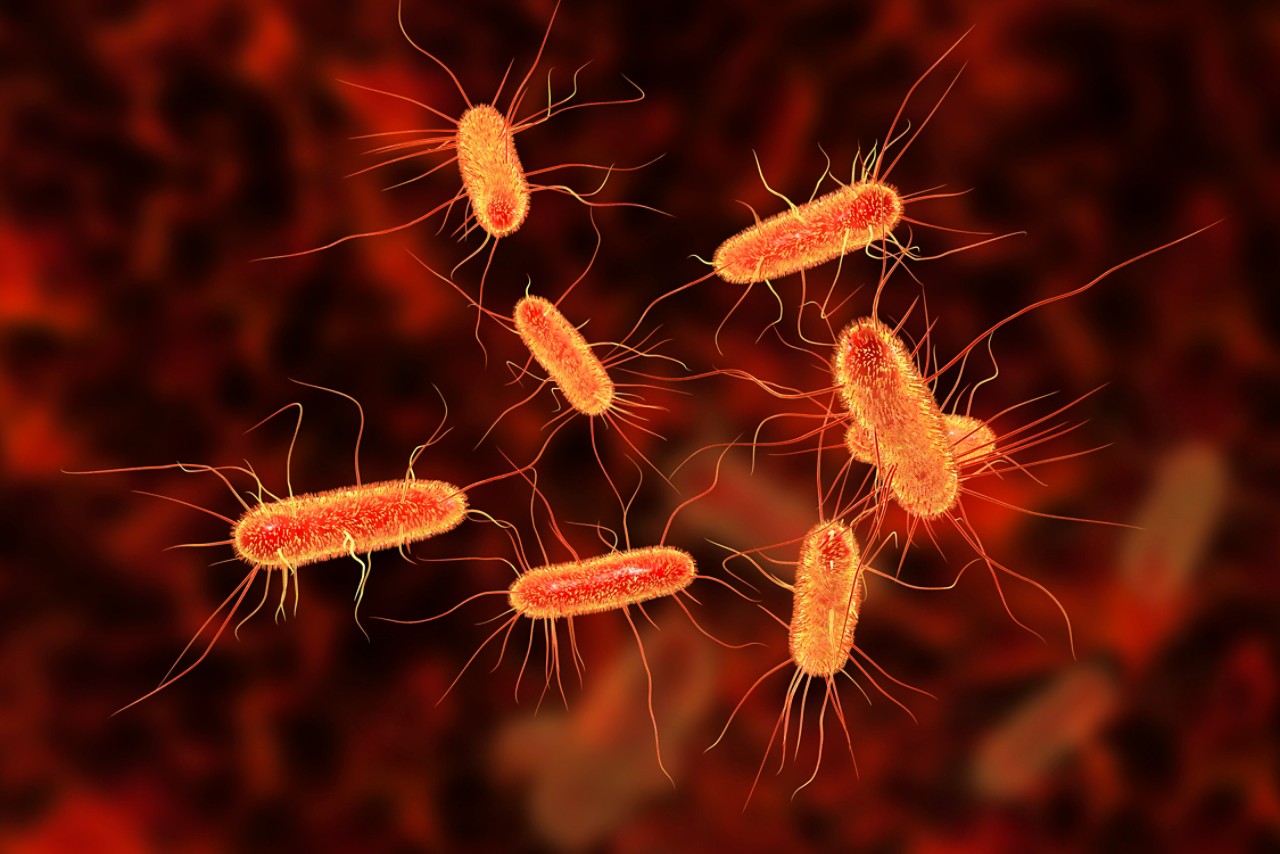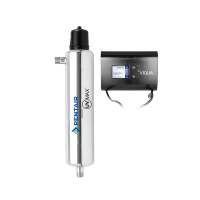- Water Softening & Filtration
- Education
- Learn About UV Water Treatment
At Pentair, we’re experts on the various methods available to filter, treat, or disinfect the water in your home. One popular type of said home water solution is ultraviolet – or UV – light technology. UV disinfection systems are designed to reduce potentially harmful pathogens, viruses, bacteria or other microorganisms that can be present in a water supply. You may remember these terms from your school science class, but if you don’t recall the specifics, stick with us and we’ll teach you the “how,” “why,” and “what” of UV light as a water treatment solution.
How Do UV Filters Work
By installing a UV system at the point where water enters your home (a.k.a. point-of-entry systems) you can treat the water in your home by reducing viral and bacterial impurities and contaminants. It’s a common misconception that UV technology improves the water in your home by outright killing these bacteria, viruses, and microorganisms, but that’s not exactly right. More accurately, a UV system uses ultraviolet light to zap unwanted pathogens, deactivating their DNA, rendering them inept and unable to reproduce. Here’s how the process works within the UV system:
- As water enters your home, it moves through a stainless-steel reactor where it is exposed to a UV lamp.
- UV light inactivates the bacteria in the water, rendering them unable to reproduce or function, reducing the risk of infection.
- Once the water has passed through the chamber, the treated water is distributed to every tap in your home.
Is UV Treatment Safe?
When used correctly, yes. Here are few reasons why:
- UV light can inactivate pathogens which makes it a trusted disinfectant.
- Select Pentair Water Solutions UV systems are certified by NSF, a non-profit organization that ensures water treatment products comply with specific standards for safety, quality or performance.
- UV systems provide chemical-free water disinfection to limit the use of chlorine or chemical byproducts.
- UV treatment will not negatively affect your water’s taste or odor.
What Does a UV Filter Treat?
While UV treatment doesn’t necessarily remove pathogens and organisms, it does keep them in check by altering their DNA or cell wall. Unable to reproduce, bacteria and viruses are inactivated and present a reduced threat in your water when treated with UV light.
Some common microbial contaminants that UV filters target include:
E. coli
E. coli is associated with fecal contamination from agricultural runoff and sewage. Most strains of E. coli are harmless, but a particular strain, 1057:H7, produces a potent toxin that can cause severe illness, according to the Centers for Disease Control and Prevention (CDC).
Select Pentair UV filters are certified by the NSF to kill 99.9% of bacteria like E. coli. Each certified system is independently tested and approved for use in cities requiring certified units.

Cryptosporidium*
Cryptosporidium are microscopic parasites that can cause diarrheal disease. According to the CDC, the parasite has an outer shell that makes it resistant to standard chlorine treatments. The CDC classifies Cryptosporidium as one of the leading causes of waterborne illness.
Some UV filters are able to eradicate up to 99.9% of most protozoa, including Cryptosporidium.

Giardia*
Giardia, a microscopic parasite similar to Cryptosporidium, is also linked to severe diarrhea. It can survive in the environment and your body for substantial periods of time because of its outer shell which, like Cryptosporidium, makes Giardia more resistant to chlorine treatments. Giardia infection is a common cause of waterborne disease in the United States, according to the CDC.
The CDC recommends point-of-use filters that are tested and certified by NSF to effectively reduce Giardia in your drinking water.

Hepatitis A
Hepatitis A is a viral liver disease. According to the CDC, the disease ranges in severity and can last from several weeks to a few months. One way Hepatitis A can enter a water system is in the fecal matter of an infected person.
Some UV treatment products can eradicate up to 99.9% of viruses like Hepatitis A from drinking water.

How To Test Your Water for Total Coliform
According to the Environmental Protection Agency (EPA), total coliforms are a group of related bacteria, such as a variety of parasites and viruses, known as pathogens, which are typically not harmful if ingested by humans, but can be an indicator of other pathogens in the water.
The EPA’s Public Notification Rule requires that your local public water system notify you if there is a problem detected in your drinking water. If you get your water from a private well, you are responsible for maintaining your water’s cleanliness and testing it. The EPA does not regulate privately-owned wells.
If you believe the drinking water in your home may contain total coliforms, we recommend that you conduct a water test at home. Our 16-Point Rapid Water Test will check your water for 16 common contaminants, including total coliform, arsenic, and lead, as well as your water’s hardness level.
Water Filters That Use UV Light
There are multiple models of UV disinfection solutions. To identify the ideal UV treatment for your home, it’s helpful to determine the optimal target dosage and flow rate for your dwelling. We make it easy to identify the UV solution that’s right for you once you have these two measurements. Follow these steps to find your ideal UV treatment system:
1. Identify Your Home’s Water Source
- City/Municipal Water
- Well Water
- Surface Water (lakes, streams, ponds, springs)
2. Determine the Recommended UVT Dosage
Ultra Violet Transmittance (UVT) is a measure of the percentage of light that passes through a water sample. The quality of the water affects how well the UV light can transmit through it. It is essential to know your UVT when purchasing a UV system, as it will affect the dosage your system is capable of producing.
The UV dosage required is the intensity of UV light that can penetrate each liter of water measured in millijoules per liter (or mJ/cm2) that passes through the UV chamber. The UVT of your water supply determines the dosage required for proper disinfection.
- 16 mJ/cm2 - This is standard UV disinfection.
- 30 mJ/cm cm2 - This will provide UV disinfection for well water with unknown or high levels of bacterial content or where the well water source is known to contain high levels of bacteria.
- 40 mJ/cm2 - This is the EPA and NSF dosage standard to treat bacterial contamination on all water supply types, including city, well, and surface water. If you have hard water, you might consider investing in a Water Softener or Water Softener Alternative for pretreatment prior to a UV water filter system to help ensure effective microbial contaminant reduction.
3. Calculate Your Flow Rate
Quickly figure out the flow rate you need by counting the number of regularly-used bathrooms in your home. Count any half-baths as a full bathroom.
- 1-3 bathroom = 10 gpm
- 4-6 bathroom = 15 gpm
4. Choose Your UV Water Filter System
To achieve proper disinfection of your water, choose the correct UV system based on your UVT, dosage requirements, and water flow rate. The chart below helps determine which system will best fit your needs. Pentair Water Solutions sells select UV systems that are certified to reduce up to 99.99% of most microorganisms (bacteria) for higher quality water.
Which System Type Should You Choose?
Non-Monitored Systems
This system is the most commonly used system for residential homes and, in standard conditions, is recommended for all homeowners who need to disinfect their water.
If you’re interested in this type of system, check out our Basic UV Systems.
Non-Monitored Class B NSF Systems
If your local county or state dictates that you purchase an NSF Certified Class B UV System, we recommend you choose a UV system that will produce 16m/J dosage. All UV models are NSF Certified and deliver a 16 m/J dosage. These systems provide supplemental bactericidal treatment of public drinking water or other drinking water supplies. Use the chart below to choose the validated model based on your flow rate.
For Pentair’s Non-Monitored Class B NSF System, see the Standard UV Disinfection System.
Monitored Class A NSF Systems
If your local county or state requires that you purchase an NSF Certified, Class A UV System, we recommend you choose a UV system that will produce 40m/J dosage. All Premium UV models are NSF Certified and provide a 40 m/J dosage. These systems reduce microorganisms from contaminated water, including bacteria and viruses, to a safe level. Use the chart below to choose the Premium model based on your flow rate.
| 99.99% Disinfection Requirement | Your Flow Rates (gallons per minute) | ||||||
| UVT Required | Dosage | 4 | 6 | 10 | 12 | 13.5 | 15 |
| Non-Monitored Systems - Basic UV Systems | |||||||
| City Water > 95% | 16 mJ/cm2 | PUV-7 | PUV-7 | PUV-7 | PUV-7 | PUV-7 | PUV-7 |
| Well Water >85% | 30 mJ/cm2 | PUV-7 | PUV-7 | PUV-14 | PUV-14 | PUV-14 | PUV-14 |
| Surface Water >75% | 40 mJ/cm2 | PUV-7 | PUV-7 | PUV-14 | PUV-14 | PUV-14 | PUV-14 |
| Non-Monitored Class B NSF Certified Systems – Standard UV Systems | |||||||
| City Water 75%-100% | 16 mJ/cm2 | PUV-8 | PUV-8 | PUV-16 | PUV-16 | PUV-16 | PUV-16 |
| Monitored Class A NSF Certified Systems – Premium UV Systems | |||||||
| Well & Surface Water 75%-100% | 40 mJ/cm2 | UV Pro 10 | UV Pro 10 | UV Pro 10 | UV Pro 20 | UV Pro 20 | UV Pro 20 |
Hopefully your UV education has you feeling like a UV valedictorian. But if you have any outstanding questions about our products or what UV treatment can do for your home’s water quality, be sure to contact a Pentair Water Solutions water expert today.
*NSF/ANSI Standard 53 certified to reduce cysts such as Cryptosporidium and Giardia by mechanical means.




